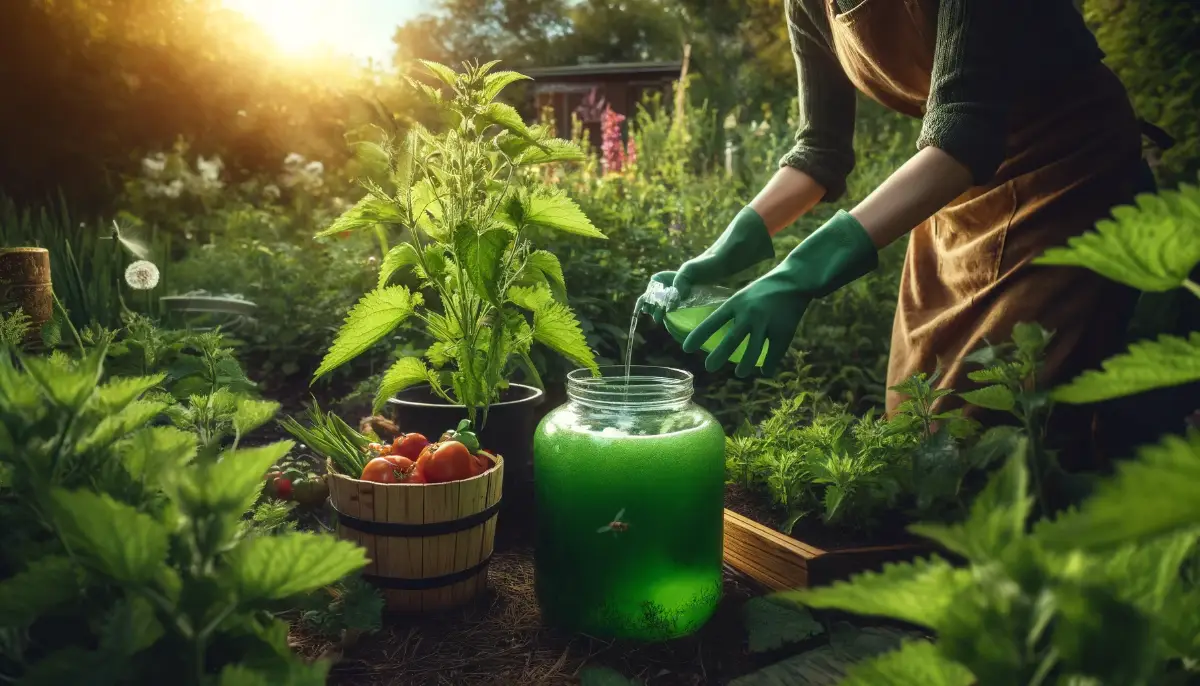Liquid seaweed, derived from various species of marine algae, offers a rich source of nutrients, growth-promoting compounds, and beneficial microorganisms. Its unique composition makes it a valuable addition to any gardener’s toolkit, providing numerous benefits that contribute to vibrant plant growth, improved soil fertility, and enhanced resilience against environmental stressors.
This guide aims to delve into the world of liquid seaweed, exploring its benefits and offering practical insights on how to incorporate it into your gardening routine. From understanding its nutrient profile to mastering application techniques, this comprehensive resource will equip you with the knowledge and confidence to harness the power of liquid seaweed for a flourishing garden.
What is Liquid Seaweed
Liquid seaweed is produced through the extraction of nutrients and bioactive compounds from seaweed biomass. Different species of seaweed, such as Ascophyllum nodosum, Ecklonia maxima, and Sargassum, are commonly used in the production of liquid seaweed due to their high nutrient content and growth-promoting properties.
Nutrient Composition
Seaweed is renowned for its rich array of essential nutrients, trace minerals, vitamins, and plant growth regulators. These include:
- Macronutrients: Nitrogen (N), Phosphorus (P), Potassium (K)
- Micronutrients: Iron (Fe), Zinc (Zn), Manganese (Mn), Copper (Cu), Boron (B), Molybdenum (Mo)
- Plant Growth Regulators: Auxins, Cytokinins, Gibberellins, Betaines
- Biostimulants: Mannitol, Alginates, Laminarin, Fucoidans
The diverse nutrient profile of liquid seaweed contributes to its multifaceted benefits for plant growth, soil health, and stress tolerance.
Types of Liquid Seaweed Products Available
Liquid seaweed products come in various forms, including concentrates, emulsions, and extracts. These products may differ in their processing methods, nutrient concentrations, and application instructions.
Common types of liquid seaweed products include:
- Concentrated Extracts: Highly potent formulations requiring dilution with water before application.
- Emulsions: Pre-diluted solutions suitable for direct application to plants or soil.
- Organic Combinations: Blends of liquid seaweed with other organic fertilizers or additives for enhanced efficacy.
It’s essential to choose a liquid seaweed product that aligns with your gardening needs and preferences, considering factors such as nutrient content, application method, and compatibility with your gardening practices.
Benefits of Liquid Seaweed
Liquid seaweed offers a myriad of benefits for both plants and the soil, making it a valuable addition to any gardening regimen. From enhancing plant growth to improving soil structure, the advantages of using liquid seaweed are vast and multifaceted.
Improved Soil Structure and Fertility
Enhanced Nutrient Availability: Liquid seaweed contributes to the enrichment of soil with essential nutrients, including nitrogen, phosphorus, potassium, and micronutrients. These nutrients are readily absorbed by plants, promoting healthy growth and development.
Increased Soil Microbial Activity: The bioactive compounds present in liquid seaweed stimulate beneficial microbial populations in the soil. This enhanced microbial activity improves nutrient cycling, soil aeration, and overall soil health.
Soil Conditioning: Liquid seaweed helps improve soil structure by enhancing water retention, drainage, and aggregation. This promotes root development and facilitates nutrient uptake by plants.
Enhanced Plant Growth and Development
Stimulated Seed Germination: Liquid seaweed contains natural growth promoters, such as cytokinins and auxins, which promote seed germination and seedling vigor.
Increased Photosynthetic Efficiency: The nutrients and biostimulants in liquid seaweed contribute to improved photosynthetic efficiency in plants, resulting in healthier foliage, increased biomass production, and higher yields.
Faster Root Development: The application of liquid seaweed promotes robust root growth and proliferation, enabling plants to access water and nutrients more efficiently. This enhances plant resilience to environmental stressors, such as drought and nutrient deficiencies.
Increased Resistance to Pests and Diseases
Induced Systemic Resistance: Liquid seaweed stimulates the plant’s natural defense mechanisms, leading to enhanced resistance against pests, pathogens, and environmental stressors.
Biochemical Defense Activation: The bioactive compounds in liquid seaweed, such as betaines and antioxidants, bolster plant immunity and trigger biochemical pathways that fortify plants against disease and pest infestations.
Reduced Chemical Dependency: By bolstering plant health and resilience, liquid seaweed helps reduce the reliance on synthetic pesticides and fungicides, promoting sustainable gardening practices.
Stress Tolerance and Environmental Adaptability
Drought Resistance: The osmoprotectants present in liquid seaweed, such as mannitol and glycine betaine, help plants cope with water stress by regulating osmotic balance and reducing cellular damage.
Temperature Tolerance: Liquid seaweed enhances plant resilience to temperature extremes, enabling plants to thrive in challenging environmental conditions, such as heat waves or frost.
Salinity Tolerance: The application of liquid seaweed can mitigate the adverse effects of soil salinity, allowing plants to maintain optimal growth and productivity in saline environments.
How to Use Liquid Seaweed in the Garden
Incorporating liquid seaweed into your gardening routine is a straightforward process that can yield significant benefits for your plants and soil. From preparing the solution to applying it effectively, here’s a guide on how to make the most of this natural fertilizer:
Preparing the Liquid Seaweed Solution
- Dilution Ratio: Most liquid seaweed products come in concentrated form and require dilution with water before application. Refer to the manufacturer’s instructions to determine the appropriate dilution ratio for your specific product. Typically, a dilution ratio of 1:20 (one part seaweed extract to twenty parts water) is suitable for foliar spraying, while a 1:10 ratio may be used for soil drenching.
- Mixing Instructions: In a clean container, combine the recommended amount of liquid seaweed concentrate with water, stirring thoroughly to ensure uniform mixing. Use lukewarm water to aid dissolution and enhance nutrient availability.
- Storage: Store any unused liquid seaweed solution according to the manufacturer’s instructions, ensuring proper sealing and protection from direct sunlight. Proper storage helps maintain the efficacy of the solution for future use.
Application Methods
Foliar Spray:
- Use a handheld sprayer or garden sprayer to apply the diluted liquid seaweed solution directly to the foliage of plants.
- Apply the solution in the early morning or late afternoon to minimize the risk of leaf burn and maximize absorption.
- Ensure thorough coverage of both upper and lower leaf surfaces for optimal nutrient uptake.
- Repeat foliar applications every 2-4 weeks during the growing season or as needed based on plant requirements and environmental conditions.
Soil Drench:
- Pour the diluted liquid seaweed solution directly onto the soil around the base of plants, ensuring even distribution.
- Water the soil lightly before and after applying the solution to aid absorption and prevent nutrient runoff.
- Adjust the application rate based on the size of the plant and soil moisture levels, avoiding over-saturation.
- Apply soil drenches every 4-6 weeks during the growing season to replenish soil nutrients and promote root development.
Seed Treatment:
- Soak seeds in a diluted liquid seaweed solution for several hours before planting to enhance germination rates and seedling vigor.
- Alternatively, apply the solution as a soil drench immediately after sowing seeds to provide early nutritional support for emerging seedlings.
Frequency and Timing of Application
Regular Maintenance: Incorporate liquid seaweed applications into your regular garden maintenance routine to provide ongoing nutritional support for plants.
Growth Stages: Tailor the frequency and timing of applications based on the specific needs of plants and their growth stages. For example, increase applications during periods of rapid growth or stress, such as flowering, fruiting, or extreme weather conditions.
Seasonal Considerations: Adjust application frequency seasonally, with more frequent applications during the active growing season and reduced frequency during periods of dormancy or low metabolic activity.
Compatibility with Other Fertilizers and Pesticides
Integrated Approach: Liquid seaweed can be used in conjunction with other organic fertilizers, soil conditioners, and pest management products to create a holistic approach to plant care.
Compatibility Testing: Before combining liquid seaweed with other products, perform compatibility tests on a small scale to ensure that no adverse interactions occur.
Sequential Application: If applying multiple products, stagger the application timings to allow for optimal absorption and minimize potential conflicts.
Tips for Maximizing Benefits
To ensure optimal results and harness the full potential of liquid seaweed in your garden, consider the following tips:
Choosing the Right Product
Quality Matters: Select a high-quality liquid seaweed product from reputable manufacturers or suppliers. Look for products that are derived from sustainably harvested seaweed and processed using gentle extraction methods to preserve nutrient integrity.
Check Nutrient Content: Review the nutrient analysis of the liquid seaweed product to ensure it contains adequate levels of essential macro and micronutrients for your plants’ needs.
Proper Storage and Handling
Store in a Cool, Dark Place: To maintain the efficacy of liquid seaweed, store it in a cool, dark location away from direct sunlight and extreme temperatures.
Seal Containers Tightly: Ensure that containers are tightly sealed to prevent moisture ingress and preserve the quality of the product.
Monitoring Plant Response
Observe Plant Growth: Regularly monitor the growth and development of plants after applying liquid seaweed to gauge its effectiveness. Look for signs of improved vigor, increased flowering, and overall plant health.
Adjust Application Rates: Based on plant response, adjust the frequency and concentration of liquid seaweed applications as needed. Some plants or soil conditions may require more frequent or higher concentrations of seaweed fertilizer for optimal results.
Timing Applications Strategically
Early Growth Stages: Initiate liquid seaweed applications early in the growing season to provide young plants with a nutrient boost for vigorous establishment.
During Active Growth Phases: Increase the frequency of applications during periods of active growth, such as flowering, fruiting, or vegetative expansion, to support plants’ increased nutritional demands.
Prioritize Stressful Conditions: Apply liquid seaweed during periods of environmental stress, such as drought, heatwaves, or transplant shock, to help plants cope with adversity and maintain vitality.
Combine with Other Organic Inputs
Complement with Organic Amendments: Combine liquid seaweed applications with other organic inputs, such as compost, aged manure, or organic mulches, to further enrich soil fertility and improve soil structure.
Rotate with Different Fertilizers: Rotate liquid seaweed with other organic fertilizers or soil amendments to provide a diverse array of nutrients and beneficial microbial activity to the soil.
Practice Sustainable Gardening Techniques
Mulch Application: Apply organic mulches, such as straw, wood chips, or shredded leaves, to conserve soil moisture, suppress weed growth, and enhance soil microbial activity.
Water Management: Implement water-efficient irrigation practices, such as drip irrigation or soaker hoses, to minimize water wastage and promote deep root growth.
Crop Rotation: Rotate crops annually to prevent soil depletion and reduce the buildup of pests and diseases associated with monoculture planting.
FAQs about using liquid seaweed in the garden
What exactly is liquid seaweed, and how is it made?
Liquid seaweed is a natural fertilizer derived from various species of marine algae. It is made through the extraction of nutrients and bioactive compounds from seaweed biomass using gentle processing methods that preserve its nutritional integrity.
What are the main benefits of using liquid seaweed in the garden?
Liquid seaweed offers numerous benefits, including improved soil structure and fertility, enhanced plant growth and development, increased resistance to pests and diseases, and enhanced stress tolerance and environmental adaptability.
How does liquid seaweed compare to synthetic fertilizers?
Unlike synthetic fertilizers, which may contain chemicals and artificial additives, liquid seaweed is a natural and sustainable fertilizer that provides a diverse array of nutrients, trace minerals, and plant growth regulators in a bioavailable form.
Can liquid seaweed be used on all types of plants?
Yes, liquid seaweed can be used on a wide variety of plants, including ornamentals, vegetables, fruits, herbs, and trees. It is suitable for both indoor and outdoor gardening, as well as for container plants and raised beds.
Is liquid seaweed safe for organic gardening?
Yes, liquid seaweed is considered a suitable input for organic gardening practices. It is derived from natural sources and does not contain synthetic chemicals or genetically modified organisms (GMOs), making it compliant with organic certification standards.
How often should I apply liquid seaweed to my plants?
The frequency of liquid seaweed applications depends on factors such as plant type, growth stage, environmental conditions, and soil fertility. As a general guideline, apply liquid seaweed every 2-4 weeks during the growing season, adjusting as needed based on plant response.
Can liquid seaweed be used in combination with other fertilizers or pesticides?
Yes, liquid seaweed can be used in conjunction with other organic fertilizers, soil conditioners, and pest management products. However, it’s essential to perform compatibility tests on a small scale before combining products to avoid any adverse interactions.
Can liquid seaweed be applied directly to plant foliage?
Yes, liquid seaweed can be applied as a foliar spray, providing plants with direct access to nutrients and growth-promoting compounds. Ensure thorough coverage of both upper and lower leaf surfaces for optimal absorption.
Can liquid seaweed help improve soil quality in my garden?
Yes, liquid seaweed contributes to improved soil structure and fertility by enhancing nutrient availability, increasing soil microbial activity, and promoting soil conditioning. Regular applications can help build healthy, nutrient-rich soil over time.
Is liquid seaweed environmentally friendly?
Yes, liquid seaweed is considered an environmentally friendly fertilizer option. It is derived from renewable marine resources and undergoes minimal processing, resulting in a low environmental footprint compared to some synthetic fertilizers.










